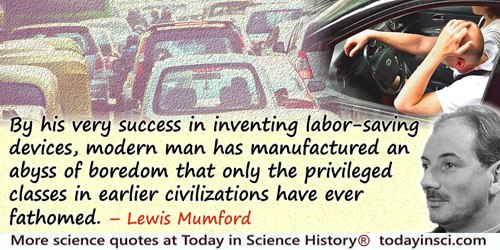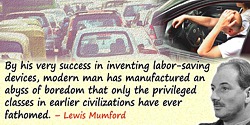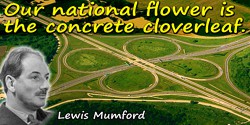 (source)
(source)
|
Lewis Mumford
(19 Oct 1895 - 26 Jan 1990)
American architectural critic, urban planner and historian who analyzed the effects of technology and urbanization on human societies throughout history.
|
Science Quotes by Lewis Mumford (15 quotes)
By his very success in inventing labor-saving devices, modern man has manufactured an abyss of boredom that only the privileged classes in earlier civilizations have ever fathomed.
— Lewis Mumford
The Conduct of Life (1951), 14.
However far modern science and technics have fallen short of their inherent possibilities, they have taught mankind at least one lesson: Nothing is impossible.
— Lewis Mumford
Technics and Civilization (1934), 435.
In a figurative sense, civilization marches up and down the valley-section: all the great historic cultures … have thriven through the movement of men and institutions and inventions and goods along the natural highway of a great river.
— Lewis Mumford
In Technics and Civilization (2010), 60-61. The ellipsis replaces: “with the partial exception of those secluded maritime cultures in which the seas sometimes served instead of a river.” The quote ends with examples of such rivers: “the Yellow River, the Tigris, the Nile, the Euphrates, the Rhine, the Danube, the Thames.” Note that a “valley section” diagrams a longitudinal survey of local characteristics changing along the river from its source in the hills and stretching to the sea (as coined by Patrick Geddes).
In our concern for the whooping crane we are at once symbolizing and concealing a far deeper anxiety—namely, the prospective total extermination of all species.
— Lewis Mumford
In My Works and Days: A Personal Chronicle (1979), 452.
In the conception of a machine or the product of a machine there is a point where one may leave off for parsimonious reasons, without having reached aesthetic perfection; at this point perhaps every mechanical factor is accounted for, and the sense of incompleteness is due to the failure to recognize the claims of the human agent. Aesthetics carries with it the implications of alternatives between a number of mechanical solutions of equal validity; and unless this awareness is present at every stage of the process … it is not likely to come out with any success in the final stage of design.
— Lewis Mumford
From 'The Esthetic Assimilation of the Machine', Technics and Civilization (1934), 349.
Iron and coal dominated everywhere, from grey to black: the black boots, the black stove-pipe hat, the black coach or carriage, the black iron frame of the hearth, the black cooking pots and pans and stoves. Was it a mourning? Was it protective coloration? Was it mere depression of the senses? No matter what the original color of the paleotechnic milieu might be it was soon reduced by reason of the soot and cinders that accompanied its activities, to its characteristic tones, grey, dirty-brown, black.
— Lewis Mumford
Technics and Civilisation (1934), 163.
Looking back over the last thousand years, one can divide the development of the machine and the machine civilization into three successive but over-lapping and interpenetrating phases: eotechnic, paleotechnic, neotechnic … Speaking in terms of power and characteristic materials, the eotechnic phase is a water-and-wood complex: the paleotechnic phase is a coal-and-wood complex… The dawn-age of our modern technics stretches roughly from the year 1000 to 1750. It did not, of course, come suddenly to an end in the middle of the eighteenth century. A new movement appeared in industrial society which had been gathering headway almost unnoticed from the fifteenth century on: after 1750 industry passed into a new phase, with a different source of power, different materials, different objectives.
— Lewis Mumford
Technics and Civilisation (1934), 109.
Our machines have often approached perfection; but no similar development has been visible in the education of men.
— Lewis Mumford
As reported in 'Humanities Head', Time (8 Jun 1942), 39, No. 23, 63.
Our national flower is the concrete cloverleaf.
— Lewis Mumford
In Hugh Rawson and Margaret Miner (eds.), The Oxford Dictionary of American Quotations (), 30, citing the magazine Quote (8 Oct 1961).
The artist does not illustrate science; … [but] he frequently responds to the same interests that a scientist does, and expresses by a visual synthesis what the scientist converts into analytical formulae or experimental demonstrations.
— Lewis Mumford
'The Arts', in Charles Austin Beard, Whither Mankind: a Panorama of Modern Civilization (1928, 1971), 296.
The cities and mansions that people dream of are those in which they finally live.
— Lewis Mumford
In The Story of Utopias (1922), 11.
The humanities and science are not in inherent conflict but have become separated in the twentieth century. Now their essential unity must be re-emphasized so that 20th Century multiplicity may become 20th Century unity.
— Lewis Mumford
As quoted in 'Humanities Head', Time (8 Jun 1942), 39, No. 23, 63.
The most conspicuous scientific and technical achievements of our age—nuclear bombs, rockets, computers—are all direct products of war.
— Lewis Mumford
In 'Reactions to Man’s Landing on the Moon Show Broad Variations in Opinions', The New York Times (21 Jul 1969), 6.
What it is important to realize is that automation ... is an attempt to exercise control, not only of the mechanical process itself, but of the human being who once directed it: turning him from an active to a passive agent, and finally eliminating him all together.
— Lewis Mumford
In 'The Myth of the Machine,' The Pentagon of Power (1970).
What was once called the objective world is a sort of Rorschach ink blot, into which each culture, each system of science and religion, each type of personality, reads a meaning only remotely derived from the shape and color of the blot itself.
— Lewis Mumford
In 'Orientation to Life,' The Conduct of Life (1951).
Quotes by others about Lewis Mumford (1)
Edmund Wilson attacked the pedantry of scholarly editions of literary classics, which (he claimed) took the pleasure out of reading. Extensive footnotes … spoiled the reader’s pleasure in the text. Wilson’s friend Lewis Mumford had compared footnote numbers … to “barbed wire” keeping the reader at arm’s length.
In Academic Instincts (2001), 39.
See also:
- 19 Oct - short biography, births, deaths and events on date of Mumford's birth.





 In science it often happens that scientists say, 'You know that's a really good argument; my position is mistaken,' and then they would actually change their minds and you never hear that old view from them again. They really do it. It doesn't happen as often as it should, because scientists are human and change is sometimes painful. But it happens every day. I cannot recall the last time something like that happened in politics or religion.
(1987) --
In science it often happens that scientists say, 'You know that's a really good argument; my position is mistaken,' and then they would actually change their minds and you never hear that old view from them again. They really do it. It doesn't happen as often as it should, because scientists are human and change is sometimes painful. But it happens every day. I cannot recall the last time something like that happened in politics or religion.
(1987) -- 


